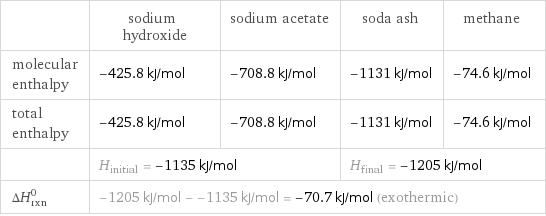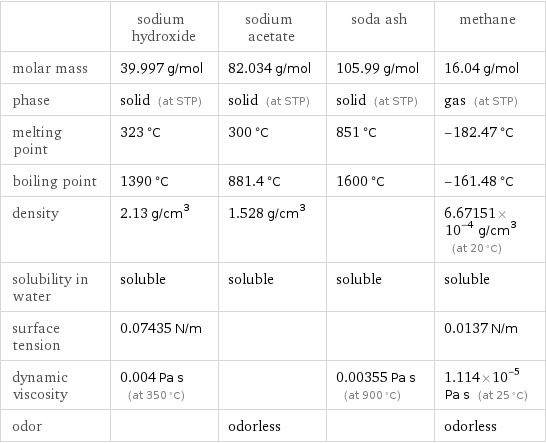Input interpretation

NaOH sodium hydroxide + CH_3COONa sodium acetate ⟶ Na_2CO_3 soda ash + CH_4 methane
Balanced equation

Balance the chemical equation algebraically: NaOH + CH_3COONa ⟶ Na_2CO_3 + CH_4 Add stoichiometric coefficients, c_i, to the reactants and products: c_1 NaOH + c_2 CH_3COONa ⟶ c_3 Na_2CO_3 + c_4 CH_4 Set the number of atoms in the reactants equal to the number of atoms in the products for H, Na, O and C: H: | c_1 + 3 c_2 = 4 c_4 Na: | c_1 + c_2 = 2 c_3 O: | c_1 + 2 c_2 = 3 c_3 C: | 2 c_2 = c_3 + c_4 Since the coefficients are relative quantities and underdetermined, choose a coefficient to set arbitrarily. To keep the coefficients small, the arbitrary value is ordinarily one. For instance, set c_1 = 1 and solve the system of equations for the remaining coefficients: c_1 = 1 c_2 = 1 c_3 = 1 c_4 = 1 Substitute the coefficients into the chemical reaction to obtain the balanced equation: Answer: | | NaOH + CH_3COONa ⟶ Na_2CO_3 + CH_4
Structures

+ ⟶ +
Names

sodium hydroxide + sodium acetate ⟶ soda ash + methane
Reaction thermodynamics
Enthalpy

| sodium hydroxide | sodium acetate | soda ash | methane molecular enthalpy | -425.8 kJ/mol | -708.8 kJ/mol | -1131 kJ/mol | -74.6 kJ/mol total enthalpy | -425.8 kJ/mol | -708.8 kJ/mol | -1131 kJ/mol | -74.6 kJ/mol | H_initial = -1135 kJ/mol | | H_final = -1205 kJ/mol | ΔH_rxn^0 | -1205 kJ/mol - -1135 kJ/mol = -70.7 kJ/mol (exothermic) | | |
Gibbs free energy

| sodium hydroxide | sodium acetate | soda ash | methane molecular free energy | -379.7 kJ/mol | -607.2 kJ/mol | -1044 kJ/mol | -51 kJ/mol total free energy | -379.7 kJ/mol | -607.2 kJ/mol | -1044 kJ/mol | -51 kJ/mol | G_initial = -986.9 kJ/mol | | G_final = -1095 kJ/mol | ΔG_rxn^0 | -1095 kJ/mol - -986.9 kJ/mol = -108.5 kJ/mol (exergonic) | | |
Equilibrium constant
![Construct the equilibrium constant, K, expression for: NaOH + CH_3COONa ⟶ Na_2CO_3 + CH_4 Plan: • Balance the chemical equation. • Determine the stoichiometric numbers. • Assemble the activity expression for each chemical species. • Use the activity expressions to build the equilibrium constant expression. Write the balanced chemical equation: NaOH + CH_3COONa ⟶ Na_2CO_3 + CH_4 Assign stoichiometric numbers, ν_i, using the stoichiometric coefficients, c_i, from the balanced chemical equation in the following manner: ν_i = -c_i for reactants and ν_i = c_i for products: chemical species | c_i | ν_i NaOH | 1 | -1 CH_3COONa | 1 | -1 Na_2CO_3 | 1 | 1 CH_4 | 1 | 1 Assemble the activity expressions accounting for the state of matter and ν_i: chemical species | c_i | ν_i | activity expression NaOH | 1 | -1 | ([NaOH])^(-1) CH_3COONa | 1 | -1 | ([CH3COONa])^(-1) Na_2CO_3 | 1 | 1 | [Na2CO3] CH_4 | 1 | 1 | [CH4] The equilibrium constant symbol in the concentration basis is: K_c Mulitply the activity expressions to arrive at the K_c expression: Answer: | | K_c = ([NaOH])^(-1) ([CH3COONa])^(-1) [Na2CO3] [CH4] = ([Na2CO3] [CH4])/([NaOH] [CH3COONa])](../image_source/b0efda32604a32ac48d04ba965654157.png)
Construct the equilibrium constant, K, expression for: NaOH + CH_3COONa ⟶ Na_2CO_3 + CH_4 Plan: • Balance the chemical equation. • Determine the stoichiometric numbers. • Assemble the activity expression for each chemical species. • Use the activity expressions to build the equilibrium constant expression. Write the balanced chemical equation: NaOH + CH_3COONa ⟶ Na_2CO_3 + CH_4 Assign stoichiometric numbers, ν_i, using the stoichiometric coefficients, c_i, from the balanced chemical equation in the following manner: ν_i = -c_i for reactants and ν_i = c_i for products: chemical species | c_i | ν_i NaOH | 1 | -1 CH_3COONa | 1 | -1 Na_2CO_3 | 1 | 1 CH_4 | 1 | 1 Assemble the activity expressions accounting for the state of matter and ν_i: chemical species | c_i | ν_i | activity expression NaOH | 1 | -1 | ([NaOH])^(-1) CH_3COONa | 1 | -1 | ([CH3COONa])^(-1) Na_2CO_3 | 1 | 1 | [Na2CO3] CH_4 | 1 | 1 | [CH4] The equilibrium constant symbol in the concentration basis is: K_c Mulitply the activity expressions to arrive at the K_c expression: Answer: | | K_c = ([NaOH])^(-1) ([CH3COONa])^(-1) [Na2CO3] [CH4] = ([Na2CO3] [CH4])/([NaOH] [CH3COONa])
Rate of reaction
![Construct the rate of reaction expression for: NaOH + CH_3COONa ⟶ Na_2CO_3 + CH_4 Plan: • Balance the chemical equation. • Determine the stoichiometric numbers. • Assemble the rate term for each chemical species. • Write the rate of reaction expression. Write the balanced chemical equation: NaOH + CH_3COONa ⟶ Na_2CO_3 + CH_4 Assign stoichiometric numbers, ν_i, using the stoichiometric coefficients, c_i, from the balanced chemical equation in the following manner: ν_i = -c_i for reactants and ν_i = c_i for products: chemical species | c_i | ν_i NaOH | 1 | -1 CH_3COONa | 1 | -1 Na_2CO_3 | 1 | 1 CH_4 | 1 | 1 The rate term for each chemical species, B_i, is 1/ν_i(Δ[B_i])/(Δt) where [B_i] is the amount concentration and t is time: chemical species | c_i | ν_i | rate term NaOH | 1 | -1 | -(Δ[NaOH])/(Δt) CH_3COONa | 1 | -1 | -(Δ[CH3COONa])/(Δt) Na_2CO_3 | 1 | 1 | (Δ[Na2CO3])/(Δt) CH_4 | 1 | 1 | (Δ[CH4])/(Δt) (for infinitesimal rate of change, replace Δ with d) Set the rate terms equal to each other to arrive at the rate expression: Answer: | | rate = -(Δ[NaOH])/(Δt) = -(Δ[CH3COONa])/(Δt) = (Δ[Na2CO3])/(Δt) = (Δ[CH4])/(Δt) (assuming constant volume and no accumulation of intermediates or side products)](../image_source/718b0c9bed97c4d815f072e39cd07bef.png)
Construct the rate of reaction expression for: NaOH + CH_3COONa ⟶ Na_2CO_3 + CH_4 Plan: • Balance the chemical equation. • Determine the stoichiometric numbers. • Assemble the rate term for each chemical species. • Write the rate of reaction expression. Write the balanced chemical equation: NaOH + CH_3COONa ⟶ Na_2CO_3 + CH_4 Assign stoichiometric numbers, ν_i, using the stoichiometric coefficients, c_i, from the balanced chemical equation in the following manner: ν_i = -c_i for reactants and ν_i = c_i for products: chemical species | c_i | ν_i NaOH | 1 | -1 CH_3COONa | 1 | -1 Na_2CO_3 | 1 | 1 CH_4 | 1 | 1 The rate term for each chemical species, B_i, is 1/ν_i(Δ[B_i])/(Δt) where [B_i] is the amount concentration and t is time: chemical species | c_i | ν_i | rate term NaOH | 1 | -1 | -(Δ[NaOH])/(Δt) CH_3COONa | 1 | -1 | -(Δ[CH3COONa])/(Δt) Na_2CO_3 | 1 | 1 | (Δ[Na2CO3])/(Δt) CH_4 | 1 | 1 | (Δ[CH4])/(Δt) (for infinitesimal rate of change, replace Δ with d) Set the rate terms equal to each other to arrive at the rate expression: Answer: | | rate = -(Δ[NaOH])/(Δt) = -(Δ[CH3COONa])/(Δt) = (Δ[Na2CO3])/(Δt) = (Δ[CH4])/(Δt) (assuming constant volume and no accumulation of intermediates or side products)
Chemical names and formulas

| sodium hydroxide | sodium acetate | soda ash | methane formula | NaOH | CH_3COONa | Na_2CO_3 | CH_4 Hill formula | HNaO | C_2H_3NaO_2 | CNa_2O_3 | CH_4 name | sodium hydroxide | sodium acetate | soda ash | methane IUPAC name | sodium hydroxide | sodium acetate | disodium carbonate | methane
Substance properties

| sodium hydroxide | sodium acetate | soda ash | methane molar mass | 39.997 g/mol | 82.034 g/mol | 105.99 g/mol | 16.04 g/mol phase | solid (at STP) | solid (at STP) | solid (at STP) | gas (at STP) melting point | 323 °C | 300 °C | 851 °C | -182.47 °C boiling point | 1390 °C | 881.4 °C | 1600 °C | -161.48 °C density | 2.13 g/cm^3 | 1.528 g/cm^3 | | 6.67151×10^-4 g/cm^3 (at 20 °C) solubility in water | soluble | soluble | soluble | soluble surface tension | 0.07435 N/m | | | 0.0137 N/m dynamic viscosity | 0.004 Pa s (at 350 °C) | | 0.00355 Pa s (at 900 °C) | 1.114×10^-5 Pa s (at 25 °C) odor | | odorless | | odorless
Units
